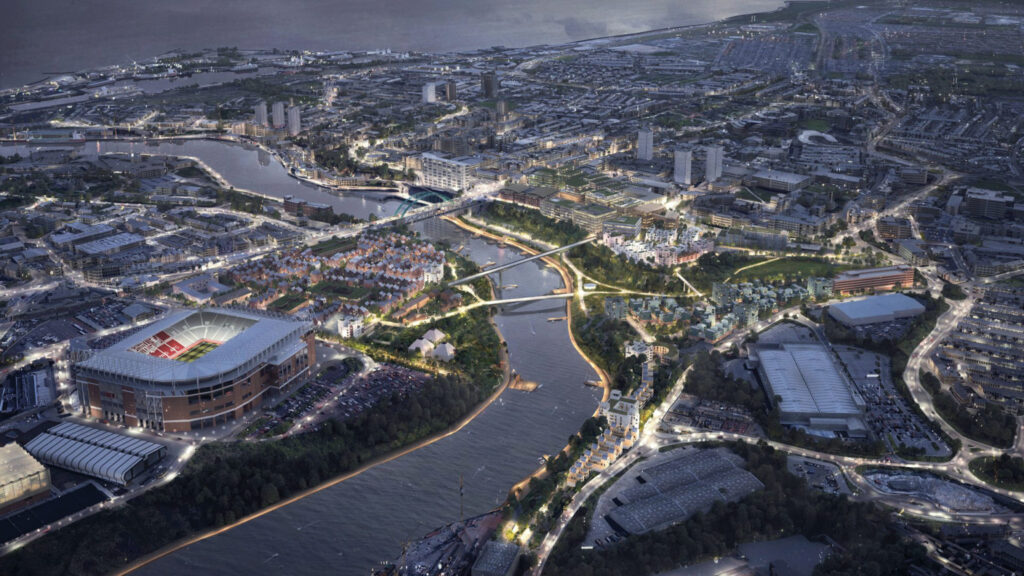Only a few years ago, Liz St Louis recalls visiting a school in one of the most deprived wards of Sunderland and how “very poor” internet connectivity was holding back students and teachers.
“The headteacher couldn’t even stream a YouTube clip in the classroom,” says St Louis, Sunderland City Council’s Director of Smart Cities and Enabling Services. “Some of the little kids coming into class had never even seen the internet.”
Thanks to a city-wide push to expand fibre connectivity, free public Wi-Fi, and a whole host of other connected infrastructure, students at that same school are now benefiting from online coding clubs. By 2025, it is expected that 95 percent of the city will be connected through gigabit-capable fibre.
“Our strategy is about leaving no one and nowhere behind in Sunderland on our journey,” she says. “It’s not always about the city centre – it’s about getting right to the heart of some of our more deprived or rural communities.”
The drive to fibre
This strategy began in 2019 when the north-eastern city in England had to face the harsh reality that the private sector was not coming forward to build the connectivity infrastructure necessary for a 21st-century city.

“No one was coming to invest in Sunderland off their own back,” St Louis says. “We had no fibre operators that had us on their roadmap. They were going off to Leeds, Manchester, Newcastle, but not Sunderland.”
Thirty of the city’s leaders were brought together and it was unanimously agreed that ubiquitous connectivity – a whole network of networks, focusing on both wired and wireless connectivity – was pivotal for the city to realise individual and collective digital ambitions. A strategy was developed over the following months, taking into consideration the marketplace and how best to tap into it.
“We used the council as an anchor in terms of our own wired connectivity,” St Louis comments. “We released a procurement for our own wide area network needs and that led to a significant investment initially by CityFibre to come in and fulfil the council’s requirement but also to invest £62 million to install fibre connectivity across the city.”
This kickstarted other companies to follow and due to Build Back Better funding post-Covid, in November 2020 the city started looking for a private sector partner to support its wireless needs and some of its smart city ambitions.
Sunderland now boasts ultra-fast free public Wi-Fi covering the whole of the city centre and the popular Roker beachfront. LoRaWAN – a low-power, wide area network – covers the whole 153 square kilometres of Sunderland, and one of the most advanced 5G private networks in the UK has been built, with a number of use cases coming to fruition.
A ‘network of networks’
The network is helping the council better meet the city’s needs and also supporting residents, businesses and the university to reach their digital potential. St Louis reels off a host of active use cases, from smart bins helping to improve collection and productivity, to saving lives through the use of smart buoys, legionella testing in buildings, leaking tap detection at sports amenities, road temperature sensors to assist road gritters in winter, air quality sensors, and sensors monitoring traffic and pedestrian flow.
“The network is coming to life,” she says. “There’s more and more being built every day and the usage is phenomenal where we’re seeing huge uptake of just basic connectivity. Everything we build or redevelop, we’re putting connectivity into as a matter of course.”
A big drive now is to focus on health and social care, including 3,800 properties installed with assistive technologies. This includes technology that can close curtains and switch lights on, sensors on doors to help monitor early onset dementia, and sensors on fridges and kettles to monitor hydration and nutrition. This all aims to support people to live safely and independently at home.
St Louis mentions one case with a severely disabled girl who was completely reliant on her parents for everything. Through connectivity and simple digital devices like smart speakers she has gained some independence.
“She can now close her own blinds, put her own fairy lights on around her bed, and put on audio stories to send her to sleep,” St Louis says. “This child’s thriving on that little bit of independence. It’s things like this when you just think: ‘wow, it really does have transformational power’.”
Defeating short-termism
St Louis is grateful to private sector partners including Boldyn Networks and Microsoft, among others, that share the city’s long-term planning and strategy. She advises other cities to also think long-term and take a whole systems approach.
“You can’t build a smart city overnight,” she observes. “There’s a lot of short-termism in this world where it’s very opportunistic to grab a bit of funding, and say: ‘We’ll do a little R&D project over here, or we’ll do a trial and testbed over there’, but it’s important to ask how do you scale and how do you make things sustainable.”
Because of those long-term strategic partners, the city is able to build, develop and continue to deliver on a network of networks and a whole array of use cases that now sit on those networks.
St Louis’ ultimate goal is to eradicate digital exclusion and ensure that everybody’s opportunity is met.
“A thriving connected city means people are healthier through the power of technology, they are happier, they are earning more money, and their aspirations around starting their own business are coming to fruition,” she says. “You can see the city thrive through ultimately underpinning connectivity and the digital and data opportunities that that affords.”
